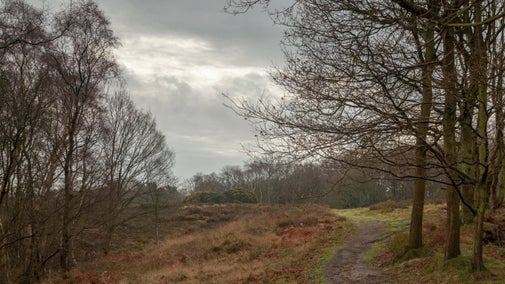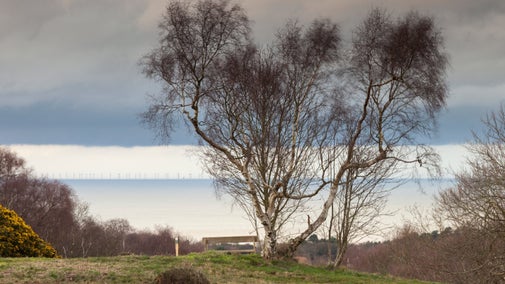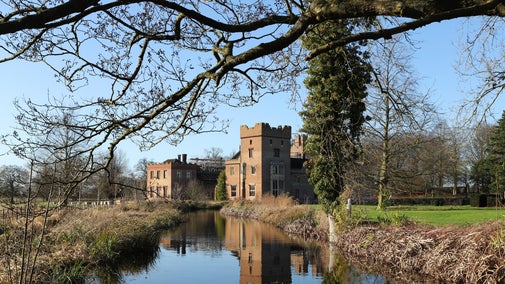
Donate
Everyone needs nature, now more than ever. Donate today and you could help people and nature to thrive at the places we care for.

The team at West Runton and Beeston Regis Heath work hard to protect and conserve the woods and heaths in our care. Learn about our work in regenerating declining heathland habitats, and how we manage the woodland to encourage and support biodiversity.
Lowland heath is a valuable but rapidly declining habitat. The UK has one of the largest areas of lowland heath in Europe.
Over the centuries, heathlands were grazed by livestock. Valuable materials came from heathland, such as sand and timber, which supplied local communities with building materials. Traditionally gorse was also gathered to fire bread ovens.
These practices helped to create and maintain open areas of heathland rich in biodiversity. Since the decline of such activities, it has become increasingly important to manage heathlands and preserve this important habitat.
When West Runton came into National Trust’s care, there were several remnant heaths. Work to restore these heaths and join them up began all the way back in 1992.
There are several techniques for restoring heaths, including cutting and clearing scrub, de-stumping and even scraping off the humus. The team has used all these techniques, with the last scrape taking place in February 2010.

Heather seedlings take up to two years to appear in numbers. The team has always relied on the natural seed bank of dormant seeds and windblown seeds from surviving plants to restore the heather.
Large areas of nearly bare earth were scraped in 2010 and after many years, there are now significant areas of heather of different ages.
The heaths at West Runton are varied, with different ages of heather, gorse and bramble. This provides a diverse habitat for wildlife. You might see land animals such as common lizards, adders, grass snakes and toads. You may also see or hear green woodpeckers, while at dusk, you could hear nightjars.
Butterflies are less numerous but green hairstreaks can still be seen feeding on the heather while bramble and honeysuckle attracts silver-washed fril;aries and white admirals.. The bare earth is home to mining insects and their holes in the ground can be seen in paths. Green tiger bee just in front of your feet.tles ofyen take off
West Runton’s woodlands have grown in the valleys for centuries. The higher and level land above the valleys was kept open by animals grazing and by man traditionally cutting bracken and gorse. When that stopped the large population of rabbits kept the areas open instead.
Many of the trees you will see started growing here when myxomatosis decimated the rabbit population. Windblown seeds from silver birch grew into young trees that shaded out heathland species such as heather and other dwarf shrubs.
As lowland heath is a rare and threatened habitat, it is a priority for nature conservation. To protect it, we must manage the growth of invasive species of trees.
While keeping the growth of invasive tree species under control is important, the woodlands provide cover for common birds and deer. Muntjac deer are often seen, while roe and red deer can be visible occasionally.
The woodland edges provide shelter from strong winds and the undergrowth provides a habitat for a wide variety of species. Insects in particular need sheltered areas and low-growing flowering plants.

De Quincy Wood is a pleasant beech wood, established in 1969 with 100 saplings planted. 40 more were planted in 1973. The boundary bank at the edge of the wood has some of the oldest trees here.
Beech trees can live for hundreds of years. If you look closely, you can see that some beeches were pollarded a long time ago.
Since 1992, the team has removed the self-seeded sycamore and silver birches to ensure that the wood is developing into a typical beech wood habitat, with a carpet of beech leaves and little undergrowth.
Beechnuts are eaten by grey squirrels, mice, voles and seed eating birds such as overwintering bramblings.
Because beech trees live for so long, they provide habitats for many deadwood specialists such as hole nesting birds and wood boring insects. The bark is often home to a variety of fungi, mosses and lichens.
Incleborough Hill is a popular area for walkers. To slow down the erosion caused by walkers and heavy rain, we have added steps to the hillside. We’ve also improved access by adding a path around the western flank.
The gates, fence and paths are kept in good order and we occasionally cut the gorse to improve access and to reduce the risk of fires spreading across the heath. Bagot goats and rare-breed cattle have been used in recent years for conservation grazing. It is hoped that this will be possible again in the near future.
In the area known as Canadas, we are working to regenerate the coppice and we’re removing the pine trees which were planted as a commercial crop at a rate of 0.7 hectares each year.
We are then fencing each new area off and replanting with hazel and chestnut to re-establish coppicing in this area. Violets,wood sorrel and foxgloves are already becoming established as part of the ground flora.
The felled pines are chipped and used in the biomass boilers that provide heating to buildings on both the Felbrigg and Sheringham Estates.
At Row Heath, our work has focussed on removing the non-native Corsican pines and replacing these with native broadleaf trees including oak, beech, small-leaved lime and wild cherry. Open glades will in time provide heathland corridors for species to migrate through.
With your ongoing support, we're able to continue our vital conservation work. Thank you for helping to protect these special places.

Everyone needs nature, now more than ever. Donate today and you could help people and nature to thrive at the places we care for.
Walk through West Runton and Beeston Regis Heath and you'll discover several clues about its history, from iron ore pits to a Napoleonic War-era coastal signal station.

Discover what you might see on your visit to West Runton and Beeston Regis Heath, from sea views to wildlife such as nightjars, buzzards, badgers and white admiral butterflies.

Volunteers play an important role in conserving the habitats in our care. Find out what roles are available and how you can get involved.

We believe that nature, beauty and history are for everyone. That’s why we’re supporting wildlife, protecting historic sites and more. Find out about our work.

Read about our strategy, which focuses on restoring nature, ending unequal access and inspiring more people.
